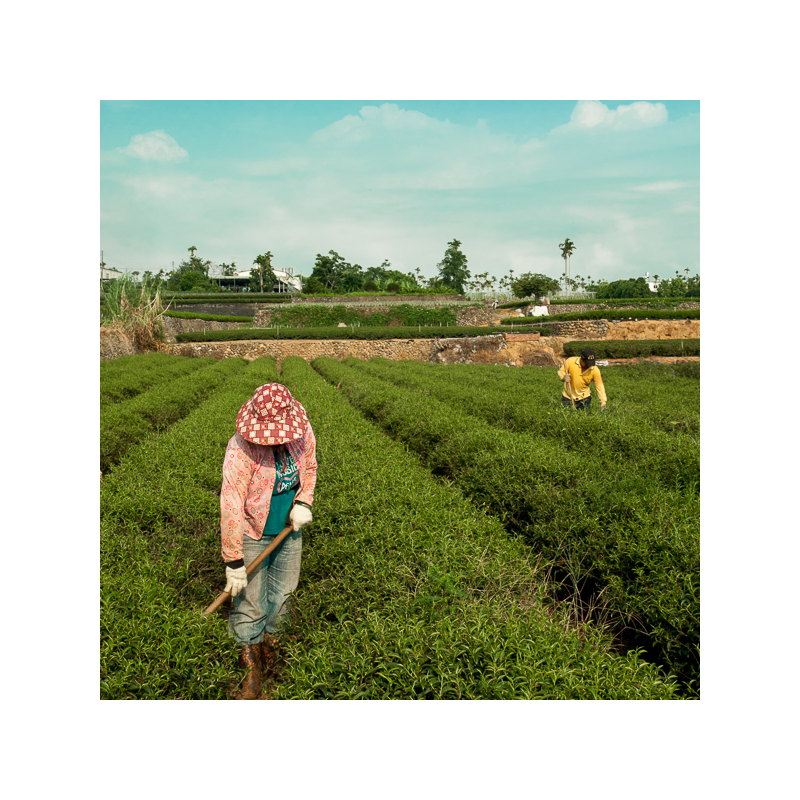Discover the wide range of Taiwan teas with this selection. The goal of this sampler is to help you choose the teas of your first order. You will better understand each type of tea after tasting them, and you'll also better know which type of tea you like best. At the same time, they will make your tastebuds travel to Formosa and enjoy the beauty of whole leaf tea.
Oolong teas are partially oxydized. This is that last tea family that has been invented, in the 1700s, in the Fujian province, right across Taiwan. It's also the most technical and complex tea to make, because the oxidation level of the leaves varies for each production (for other teas it's always the same) and it can be roasted at varying degrees. Oolongs have the broadest range of flavors, but other factors also influence the tea: the cultivar, the location of the plantation, the season of the harvest, how the leaves are harvested (by machine or hand)...
In this sampler, let's start with the biggest tea producing region of Taiwan, Mingjian in Nantou county in the center of the island. There, the most popular cultivar is SiJiChun, which means 4 seasons Spring. Its name means that this tea can be harvested all year long and produce very flowery fragrances. But the best quality for this tea comes from the late winter harvest, called Dong Pian (winter petals). That's when the nights are coolest and preserve the fresh fragrances of the leaves. That's what you can taste on this fresh SiJiChun. We can then compare this lightly oxidized Oolong with the charcoal roasted version from a similar harvest from 2012 to experience how the roast and time have transformed the flavors of this Oolong.
Then, I propose to discover two important new cultivars for Oolong tea: Jade (Tsui Yu, or Cui Yu) and Jinxuan. Both were created in the early 1980s by TRES (Taiwan Research Extension Station, Taiwan's tea research centre). With these 2 teas, you can taste the differences of these 2 new cultivars. An Oolong is considered 'high mountain' when its plantation exceeds 1000 meters altitude. Spring nights are very cool in Alishan, which helps preserve the fine flavors of the leaves. With this winter qingxin Oolong from Alishan we can taste a smaller leaf cultivar with more power. The difference in aromas with the Jinxuan mostly comes from the cultivar since all other parameters are almost the same. This is currently the most popular Oolong style in Taiwan.
We can find something quite similar with Baozhongs from Wenshan (northern Taiwan). They are also lightly oxidized and barely roasted most of the time. However, their striped shape is very different. They often have subtropical forest aromas as you can experience with this Baozhong.
Since we've tasted mostly lightly oxidized Oolongs, I propose that we also taste the other side of the oxidation spectrum. In this category, we find one of Taiwan's most famous tea, the Oriental Beauty, a jassid bitten Oolong with a high oxidation level. This one comes from its region of birth and uses the most suitable cultivar: Qingxin DaPang. Then, Taiwan also has a history of producing fully oxidized teas (Hung Cha or black teas) on the East Coast of Taiwan. It started during the Japanese occupation of the island (1895-1945). Now, the most famous red tea from that area is a based on the Da Yeh Oolong cultivar called Honey scent red tea (Mixiang hong cha). This tea is also jassid bitten and finds its inspiration in the Oriental Beauty Oolong.
Here's the list of 8 teas included in this beginner's sampler. Each tea is 25 gr:
1. 2023/24 Dong Pian SiJiChun Oolong from Mingjian
2. 2012 Spring Strong Roasted SiJiChun from Mingjian
3. 2023 Spring Jinxuan Oolong from Alishan
4. 2023 Winter Jade Oolong from Zhushan
5. 2023 Spring QingXin Oolong from Alishan
6. 2023 Spring Subtropical Wenshan Baozhong
7. 2023 Summer Oriental Beauty from Hsin Chu
8. 2021 Spring red Da Yeh tea from the East Coast of Taiwan
You make a 0.9 USD saving by purchasing this set!




